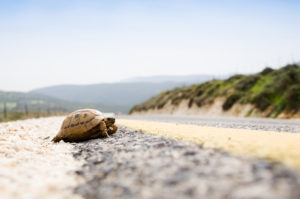 According to the global 2010 Biodiversity Indicators Partnership, about 21 million square kilometers of Earth’s surface are protected by parks, reserves, marine protected areas, and nature preserves. These areas, along with privately owned protected land, are important tools for protecting and conserving natural and cultural resources. Yet without corridors linking them-at least on a continental scale-can biodiversity truly be enhanced and safeguarded? Without easy movement to a wide range of food sources and shelter, can the keystone species of Earth’s land, water and sky survive?
According to the global 2010 Biodiversity Indicators Partnership, about 21 million square kilometers of Earth’s surface are protected by parks, reserves, marine protected areas, and nature preserves. These areas, along with privately owned protected land, are important tools for protecting and conserving natural and cultural resources. Yet without corridors linking them-at least on a continental scale-can biodiversity truly be enhanced and safeguarded? Without easy movement to a wide range of food sources and shelter, can the keystone species of Earth’s land, water and sky survive?
As practitioners and supporters of ecological restoration, conservation planning and regenerative design, what role could we play in building such links? What can we do to facilitate the necessary movement of species amidst habitats fragmented by development, deforestation, roads and agriculture? Find out, as we explore the topic of continental connectivity.
To gain a sense of what continental habitat connectivity and fragmentation look like on the ground, we’ll talk with writer, adventurer and naturalist John Davis. John recently began TrekEast, a 4,500-mile journey on foot, kayak, bicycle, canoe and skis along North America’s “Eastern Wildway.” After paddling through the Everglades, John shared some of the environmental wonders and impacts he has seen on his journey.
In our nonprofit spotlight, we’ll hear from Conrad Reining, Eastern Director of Wildlands Network, an organization dedicated to creation of protected corridors of land running coast to coast, throughout North America. Conrad describes the Wildlands Network vision of four extensive North American “Wildways.”
North America is not the only region of the world where attempts are being made to create large-scale habitat corridors. We’ll share information about efforts to create linkages on other continents.
For those who want to learn more about habitat protection and connectivity, we provide loads of links. We also share the latest news about the people, places and projects of Biohabitats and our new subsidiary, Natural Systems International.
What are YOUR thoughts on continental connectivity? Share them in the comments below, or email us about being a guest blogger!
Further Reading
Meet Assistant Construction Project Team Leader Bryan SullivanMeet Conservation Biologist Nolan Schillerstrom
Get to know Allyson Gibson, Biohabitats Extern
Get to Know Graphic Designer Joey Marshall
Evolution: A New Leadership Team for Biohabitats
More From This Author
Get to know Hanna Harper, Geospatial Analyst & Environmental ScientistThoughts on The Connections Between Ecological And Human Health
Thoughts on Novel Ecosystems
COVID-19 Alert: Nature is not cancelled.
Thoughts On Coral Reef Restoration

